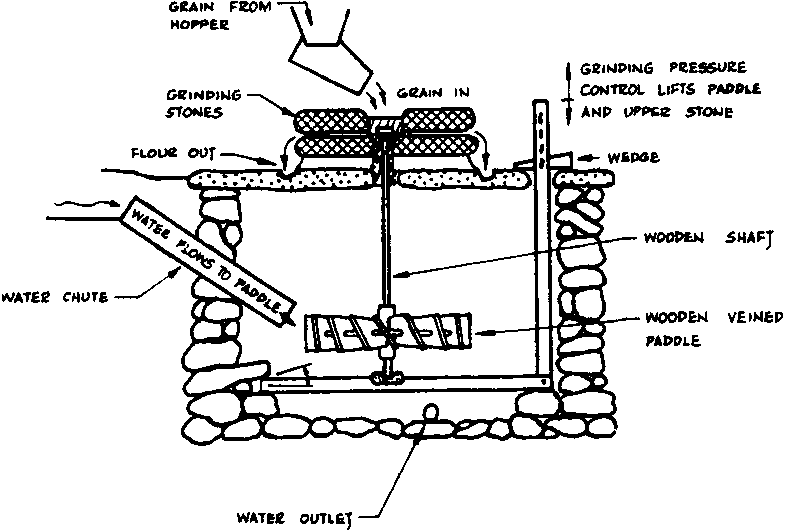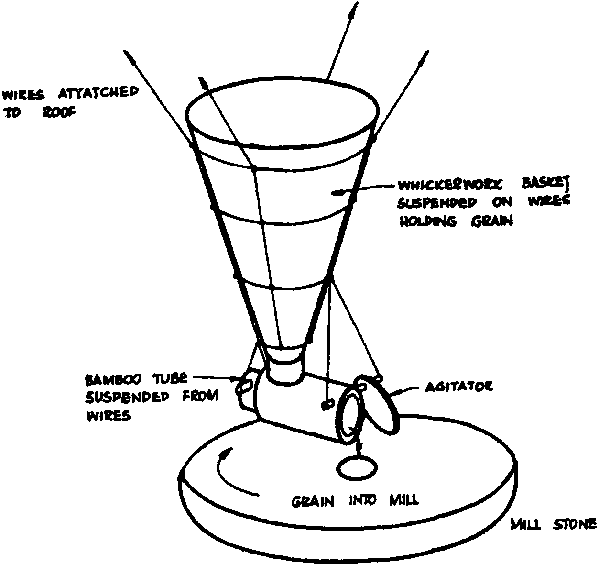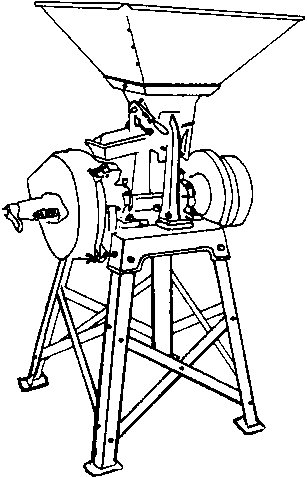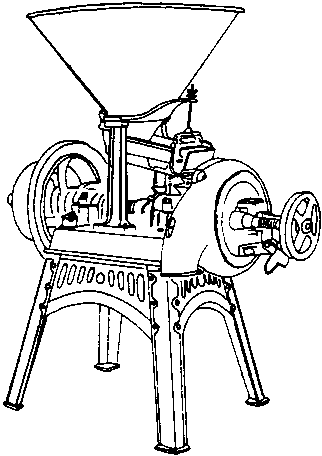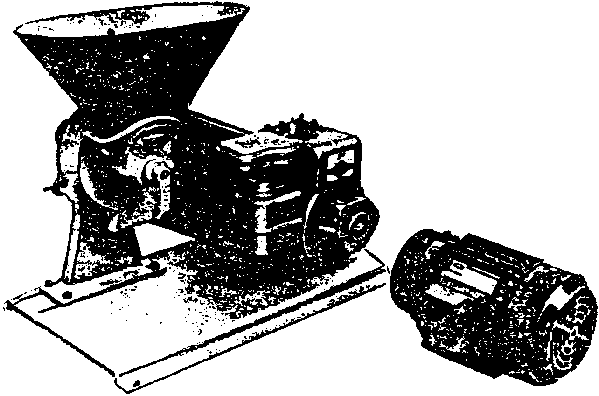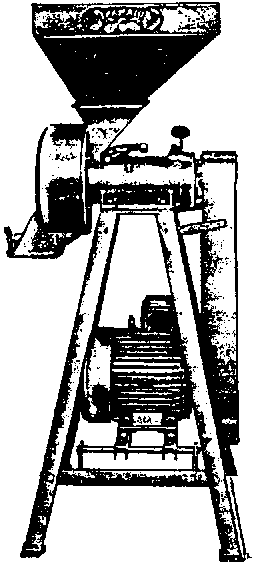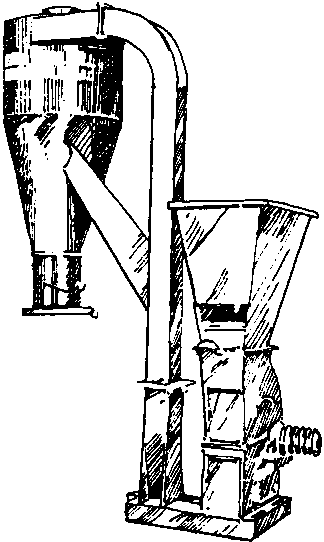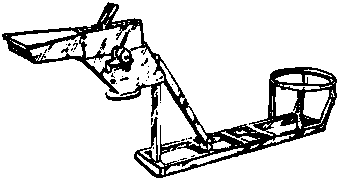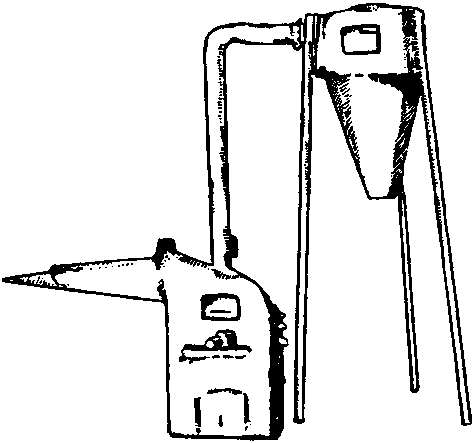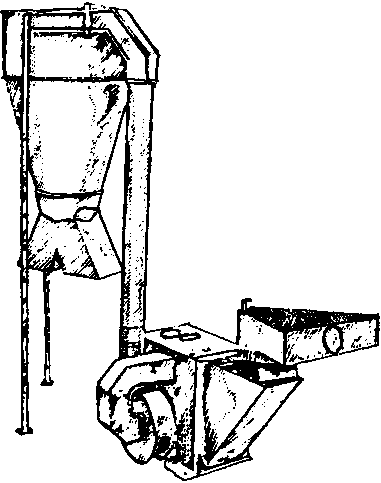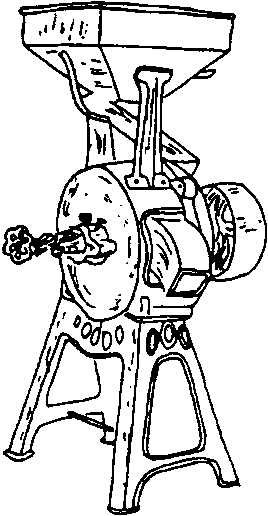There is a wide range of milling techniques used at various scales of production, and producing various types and qualities of maize meal. The smallest scales of production are associated with techniques used at the household level (e.g. use of mortar and pestle, of querns) while the largest scales of production are generally achieved by roller mills. Intermediate scales of production are associated with techniques used in stone, plate and hammer mills. Given the focus of this memorandum on small-scale production, this chapter emphasises these latter techniques, and only briefly reviews the technology used by roller mills. Milling techniques used at the household level are not considered, especially since an increasing number of rural women tend to use the services of custom or community mills in order to be able to devote more time to more productive activities.
I. PRE-TREATMENT OF MAIZE FOR MILLING[edit | edit source]
In general, untreated, shelled and dried maize grain is simply ground into a meal or flour for the preparation of traditional products. However, some traditional maize products require that the shelled grain be subjected to various pre-treatment processes prior to grinding.
In Central and South America, maize is often used at the domestic or commercial level for the preparation of tortilla, an unleavened bread. Prior to grinding, the grain is boiled in a dilute solution of sodium and calcium hydroxide for 15 to 20 minutes. This treatment loosens the bran and the tip cap which are easily removed, together with any excess alkali, by washing. At this stage, the slightly softened grain may be wet-milled in a mechanically powered plate mill to produce the tortilla dough, "masa". Where the requirement is for fresh tortillas, the "masa" is shaped and baked on the same premises. Alternatively, after alkali treatment and washing, the slightly softened grain may be dried in oil-fired or electric ovens, ground in a hammer mill, packaged and marketed as instant tortilla flour. This pre-treatment gives the final product a characteristic and much desired flavour, and improves the nutritional properties of the grain.
Maize grain may also be lightly toasted prior to milling. In Central America, a particularly popular local drink or gruel - Pinol or Pinolillo - is a commercially prepared mixture of toasted maize whole meal (milled in a hammer mill), toasted cocoa beans, other cereals and flavourings such as nutmeg or cinnamon. The toasting process improves the flavour of the maize and increases its digestible energy by gelatinising the starch. It also retards the development of rancidity by inactivating the enzymes in the meal. Thus, the shelf-life of the product is further extended.
II. REVIEW OF MAIZE MILLING TECHNOLOGIES[edit | edit source]
There are two main milling technologies: one in which the grain is directly ground without any pre-processing and one in which the grain undergoes a number of pre-processing stages prior to milling. The former milling technology yields whole meal which contains both the bran and germ, while the latter one yields a large range of products including partly or fully de-germed meals called respectively bolted and super-sifted meals.
The production of whole meal is carried out in three types of mills: plate, stone and hammer mills. The output of these mills ranges from 25 kg per hour for plate mills to over 10,000 kg per hour for some large-scale hammer mills. The technical specifications of these mills are given in table IV.1. Plate, stone and hammer mills may use various sources of energy, including water-power, diesel and electricity. Some plate mills may use animal or wind power at relatively low outputs. The whole meal produced by these mills may be further sieved for the removal of large pieces of bran and germ. The mills may be equipped with grain cleaning equipment and attached to sieving devices. Water-powered mills are mostly custom mills while the other mechanically powered mills may be either custom or merchant mills, depending on the location and scale of production. The use of plate, stone or hammer mills is usually governed by local preferences, the intended scale of production and the type of output. Plate mills are extensively used in parts of West Africa (e.g. Ghana, Nigeria, Cameroon, Sierra Leone) whilst hammer (Cameroon, Sierra Leone) whilst hammer mills are more common in East Africa (e.g. Tanzania, Kenya, Malawi). Stone mills for the dry grinding of maize prevail in Central and South America, the Indian subcontinent, North Africa and the Middle-East. Hammer mills are predominantly used for the production of ground animal feed, such as in West Africa, Indonesia and Central America.
Summary of technical data on mechanically powered, plate, hammer and stone mills
|
Characteristics |
Mill type | ||
|
Plate |
Hammer |
Stone | |
|
Speed of rotation (rpm) |
600 |
Up to 3600 |
600-800 |
|
Electric motor capacity (kW) |
|
2-150 |
|
|
Diameter of grinding plates or stones (cm) |
25 |
20-56 (v)* | |
|
Average output per kW/kg/hr |
67 |
74 |
80 (v)* |
|
Average output per hour (kg) |
27-270 |
148-11,100 |
32-1,200 (v)* |
*v: vertical millstones
*h: horizontal millstones.
The second maize milling technology is used in roller mills where the maize undergoes a series of pre-processing stages which include cleaning, tempering, de-germing, sifting, reduction, etc. These mills yield a number of maize products for various food preparations. The composition of some of these products and the milling yields are shown in table IV.2. The range of products generally varies from one mill to another depending on market requirements. The extraction rate of the dry milled products is approximately 80 per cent. In general, the majority of the output comprises prime quality grits or meals with a fat content of less than 1.0 per cent. A small proportion of the output is made up of lower quality fines or flour with a fat content of 1.0 to 2.0 per cent. The by-products (i.e. the germ and bran) make up the remaining 20 per cent of the grain input. The germ is generally further processed for the extraction of oil while the bran is used for animal feed.
Table IV.2
Typical yields and composition of de-germed maize products
|
De-germed products* |
Milling yield |
Typical particle size range |
Moisture |
Fat |
Crude fibre |
Ash |
Protein |
|
|
(Per cent) |
(mm) |
(Per cent) | ||||
|
Flaking grits |
12 |
|
14 |
|
|
|
|
|
Coarse grits |
15 |
|
13 |
|
|
|
|
|
Medium grits |
23 |
|
13 |
|
|
|
|
|
Granulated meals |
3 |
|
12 |
|
|
|
|
|
Maize flour |
4 |
Less than 0.2 |
12 |
|
|
|
|
* From a system yielding a multiple range of products. Milling yields and composition of products are dependent upon the individual processor's requirements.
The scales of operation of modern roller mills vary from 48 tonnes to 300 tonnes of maize input per 24 hours (2,000 kg to 12,500 kg per hour). However, smaller plants capable of processing as little as 7 to 9 tonnes of maize per 24 hours (300 kg to 400 kg per hour) are available, but are of limited distribution. The Indian Central Food Technological Research Institute (see Appendix II) has recently designed and developed a small-scale turnkey roller mill for the production of a limited range of maize products, particularly in rural areas. Details of design drawings are available for a nominal price directly from the Institute.
The following sections of this chapter provide detailed technical information on stone, plate and hammer mills. Roller mills are briefly covered since they are outside the scope of this memorandum.
III. WATER-POWERED MILLS[edit | edit source]
Water-powered mills are basically stone mills powered by the flow of water. A separate section (section IV.3) describes stone mills powered by diesel engines and electricity.
The use of two circular flat stone surfaces moving in a horizontal plane, one above the other, forms the basis of the typical water-powered stone mill. It is commonly used in he highlands of East Africa, the Himalayas and in the Andean region where an abundance of fast-flowing streams provides the necessary motive power. Figure IV.1 shows a cross-section of a water-powered stone mill.
Water falling at an angle of approximately 80° and at a rate of approximately 5 litres per minute causes the rotation of a wooden veined paddle beneath the millstones. This motion provides direct drive - via a vertical wooden shaft connected to the paddle - to the uppermost of a pair of horizontal millstones which rotates at a speed of approximately 120 rpm (James, 1982; Temple, 1974; Ndambuki, 1981). The grain is fed through a hopper with a 15 cm diameter hole at its base (see figure IV.2). It then reaches the gap between the two millstones which are seated on a plinth. As the rotating top stone moves against the stationary stone, the grain is carried and ground as it flows from the centre to the periphery of the stones. Grooves cut into the stones assist this passage of the grain. The depth of these grooves decreases gradually from the centre of the stones outwards, thus allowing the gradual reduction of the grain into small fragments. The ground material falls into a channel surrounding the millstones from where it is collected. The gap between the stones can be adjusted by means of a simple wedge mechanism which alters the pressure on the top stone. In this way, flour of various textures may be produced.
Figure IV.1 Cross-section of water-powered stone mill
Figure IV.2 Grain feed hopper
Source: Temple (1974)
In a typical water-powered mill, with millstone diameters of approximately 75 cm, the output of the ground material ranges from 25 to 50 kg per hour depending upon the desired fineness of the material and the rotating speed of the stones. The latter, in turn, depends upon the rate of water flow.
Water-powered mills may be made from locally available materials by village craftsmen. The millstones themselves may be locally produced and dressed or, alternatively, imported.
IV. PLATE, HAMMER AND STONE MILLS[edit | edit source]
IV.1 Plate mills[edit | edit source]
Plate mills are made of a cast iron base to which are attached two enclosed vertical grinding plates (see figure IV.3). One plate is fixed while the other is belt-driven from an electric motor (0.4 to 4 kW), or diesel engine (in the range of 11 to 19 kW). The moving plate rotates at a speed of approximately 600 rpm. Some models may, alternatively, be driven from a tractor engine. The grain is screw-fed from a conical hopper into the gap between the two plates. This gap may be adjusted to vary the fineness of the ground material. The grinding plates, approximately 25 cm in diameter, are made from hardened cast steel. They are grooved to aid the shearing (cutting and crushing) and grinding of the grain. Different plates, with a range of groove sizes, may be used for the production of meals of varying textures. The hourly output of plate mills depends upon the required fineness of the product and the variety and moisture content of the original grain. Electric plate mills have an output of approximately 67 kg per kW per hour. Thus, a plate mill equipped with a 4 kW electric motor may process approximately 270 kg of grain per hour. In parts of West Africa (e.g. Nigeria) and Central America, plate mills are used for the wet grinding of maize. For this purpose, plates with finer grooves than those used for dry milling are usually recommended by the manufacturer.
A few developing countries produce plate mills with imported engines, while other countries import the fully equipped mills. Plates IV.1 to IV.4 illustrate a few plate mills supplied by a number of manufacturers from both developing and developed countries.
Figure IV.3 Diagrammatic representation of a mechanical plate mill
Plate IV.1 "Superb" plate mill
Plate diameter: 270 mm
Power required: 5 hp
Speed: 600 rpm
Output: 230-270 kg/hrManufactured by: E.H. Bentall and Co. Ltd.,
(United Kingdom)Source: ITDG (1976)
Plate IV.2 Amuda flat plate mill No. 1
Spring mechanism allows the plate to open and avoids damage if any hard substance enters the machine. Shaker type feed mechanism can be easily regulated. Suitable for various grains.
Manufactured by: Rajan Trading Co.
(India)Source: ITDG (1976)
Plate IV.3 "Premier" 127 plate grinding mill
Output: 500 kg/hr
Power required: 1-2 hpManufactured by: R. Hunt and Co. Ltd.
(United Kingdom)Source: FAO (1979)
Plate IV.4 Diamant steel plate grinding mill
Output: 500 to 1,100 kg per hour
Power required: 5 to 15 hpManufactured by: A.B.C. Hansen Co. A/S
(Denmark)Source: ITDG (1976)
IV.2 Hammer mills[edit | edit source]
The hammer mills used in developing countries for maize dry milling are often imported from Europe or the United States. However, a growing number of these countries have started the manufacture of generally good quality hammer mills.
The design and capacity of hammer mills vary between manufacturers. In general, they comprise a cast iron body through which passes a horizontal rotary shaft powered by an external energy source (see figure IV.4). The latter is usually an electric motor or diesel engine. Occasionally, power is obtained from a tractor engine. The capacity of the electric motor varies from 2 to 150 kW depending upon the size and model of the mill.
A disc or discs, from which project short hammer-like plates, are attached to the end of the rotor shaft and enclosed in a metal casing. The hammer rotates at speeds of up to 3,600 rpm. They may be of the fixed or swinging type, and vary in number from 1 to 32. The fixed hammers are usually in the form of an iron casting whereas the swinging type are often made from heat-treated, 1.0 per cent chromium steel.
A screen, mounted on a fixed circular support, surrounds the hammers. The maize grain must be sufficiently reduced in size to pass through the screen before it is discharged from the milling chamber. A range of screens is available for the production of a variety of grades of ground material. A conical hopper, fixed above the milling chamber, holds the whole grain which is gravity fed into the mill.
Unlike the shearing action in the plate or stone mill, size reduction in a hammer mill occurs principally by impact as the grain hits the hammers, the metal of the screen, and the back wall and front casing of the mill. Impact also occurs between the grain itself. The grain is trapped and sheared between the hammer and the holes of the screen. The broken grain is retained in the milling chamber until its size is reduced sufficiently to allow its passage through the screen perforations.
The output of ground material varies according to the capacity of the motor, the size of the perforations in the screen and the variety and moisture content of the maize. As a general guide, the output per kW per hour is approximately 74 kg for maize with a moisture content of 16 per cent and a screen with 3 mm holes. In the larger models (motor capacity greater than 5 kW), a cyclone discharges the ground material and cools both the mill and the product. In the smaller models (motor capacity less than 5 kW), the ground material is discharged by gravity from the base of the mill.
Figure IV.4 Diagrammatic representation of a hammer mill
Plates IV.5 to IV.8 illustrate various hammer mills manufactured in both developed and developing countries. Table IV.3 indicates the physical characteristics of a selected number of hammer mills.
IV.3 Stone mills[edit | edit source]
In a typical stone mill, a conical or pyramid-shaped hopper holds the whole grain which enters the milling chamber through a feed valve. In some models, a shaking device and a screen prevent large impurities from entering the milling chamber. The milling of the grain is achieved by the shearing action of the flat surface of two millstones which are identical in size and construction. One stone is fixed to the milling chamber door while the other is mounted on a rotating drive shaft connected to an external energy source (e.g. an electric motor, diesel engine, or tractor engine). Figure IV.5 illustrates the basic design of a stone mill.
The grain from the hopper is fed, through the central hole in the rotating stone, into the gap between the two stones. As the rotating stone moves against the stationary stone, the grain is ground as it travels from the centre to the periphery of the stones. The two millstones may be set either horizontally with a vertical rotary shaft, or vertically with a horizontal rotary shaft. The vertical type is more common. It is shown in figure IV.5.
The diameter of the millstones varies according to model type and size. Generally, because of the weight of the stones and the relative difficulty in supporting them in an upright position, vertical millstones are smaller in diameter (20 to 56 cm) than horizontal millstones (61 to 71 cm). There are exceptions, however; some manufacturers produce vertical millstones of 71 cm and 81 cm diameter, while some horizontal millstones are only 30 cm and 41 cm in diameter. In the horizontal type, the crushed grain is moved to the periphery of the stones by centrifugal forces, whereas gravity assists the movement of crushed grain between the vertical millstones.
Table IV.3
Characteristics of selected hammer mills produced by manufacturers listed in Appendix I1
|
Manufacturer |
Model |
Type of "hammers" |
Number of "hammers" |
Use/maintenance |
Power (hp) |
Rotation (rpm) |
Suggested engine2 |
Output (kg/hr) |
Cyclone attachment |
|
ALVAN BLANCH |
ESSEX |
Reversible |
3-10 |
100-300 |
|||||
|
ETS CHAMPENOIS |
REQUIN 4 |
24 |
Reversible* |
|
3,000 |
E |
500-1,000 |
||
|
COMIA-FAO |
BNT 4000 |
|
4,000 |
E, H |
75-150 |
||||
|
DDD PRESIDENT |
MM |
6 |
Re-useable** |
3 |
3,000 |
E, 3 |
60-100 |
||
|
MM/F |
9 |
Re-useable** |
|
3,000 |
E, 2.5 |
||||
|
Z2 |
12 |
Re-useable** |
|
3,000 |
E, 5.5 |
200-300 |
|||
|
C2 |
24 |
Re-useable** |
|
3,000 |
E |
250-500 |
|||
|
B |
30 |
Re-useable** |
10 |
3,000 |
E |
300-800 |
|||
|
MP |
|
E |
200-500 |
||||||
|
ELECTRA |
BABY |
Swinging |
6 |
Reversible* |
|
6,000 |
E: 4.5-7.5 |
150-700 |
|
|
MINI |
Swinging |
6 |
Reversible* |
2-3 |
3,000 |
P |
|||
|
VS1 |
6,000 |
H: 14 |
Yes | ||||||
|
GONRAD |
T20 |
Swinging |
20 |
Reversible* |
4-8 |
5,000 |
E, H |
Yes | |
|
T24 |
Swinging |
24 |
Reversible* |
16-20 |
3,000 |
E |
Yes | ||
|
LAW |
HBU4 |
Swinging |
4 |
4; 7.5 |
E |
100-600 |
|||
|
EF |
|
3,000 |
E |
250 |
Yes | ||||
|
Centaures |
Swinging |
Welding |
12,15,25 |
3,000 |
E |
500-2,000 |
Yes | ||
|
HPB |
Swinging |
4 |
6-15 |
100-600 |
|||||
|
B15C |
|
3,000 |
E: 4kW |
150-250 |
|||||
|
NDUMEE |
ND20 |
12-25 |
4,000 |
||||||
|
ND30 |
16-100 |
3,600 |
|||||||
|
GM40 |
25-100 |
2,000-2,600 |
|||||||
|
PROMILL |
B2L |
Interchangeable |
|
1,500-3,000 |
|||||
|
B4C |
Swinging |
12 |
|
3,000 |
|||||
|
RENSON |
BM12/55 |
12 |
Reversible* |
|
3,000 |
E |
100-500 |
||
|
A5 |
15 |
|
2,800 |
E |
300 |
||||
|
B10 |
24 |
|
E |
500 |
|||||
|
C15 |
36 |
10 |
E |
700 |
|||||
|
SECA ARGOUD |
ALPIN |
Swinging |
6 |
Reversible* |
4-5.5 |
6,000 |
P: 7.5 |
150-800 |
|
|
STOUT 27 |
Swinging |
24 |
4 faces |
3,000 |
400-1,500 |
||||
|
EUROP 76 |
4 faces |
|
3,000 |
E |
600 |
Yes | |||
|
MIRACLE 71 |
4 faces |
|
3,000 |
E, D |
250-400 |
||||
|
SKJOLD |
SB |
Swinging |
16 |
Reversible* |
4-10 |
3,800 |
E, D: 11 |
300 |
Yes |
|
AM2 |
Swinging |
12 |
10-13 |
3,800 |
E, D |
120-250 |
Yes | ||
|
BM2 |
Swinging |
12 |
Reversible* |
|
2,900 |
400 |
Yes | ||
|
TIXIER |
REIXIT |
Swinging |
15, 18 |
Reversible |
|
3,000 |
E |
150-700 |
|
|
TOY |
BA |
Swinging |
|
3,000 |
150-500 |
||||
|
T1 |
12 |
Reversible* |
|
E, P, D |
Yes | ||||
|
SACM |
PM 73 |
6 |
6,000 |
E, H |
100-200 |
||||
|
BU 69 |
10 |
4,500 |
E, H |
150-300 |
|||||
|
D. SECK |
Fixed |
6 |
Reversible |
12 |
3,200 |
E, D |
|||
|
SISMAR (SISCOMA) |
E, P, D |
250-360 |
1 Source: GRET (1983)
2 Letters in this column designate the following engines: E for electric engines, D for diesel engines, H for heat engines and P for petrol engines. The numbers designate the capacity of the engine in hp.
* 4 faces
** 3 faces
Figure IV.5 Diagrammatic representation of a mechanical stone mill with vertical grinding stones
Plate IV.5 Kusinja hammer mill
The Kusinja maize mill is designed to be powered by diesel motors of between 10-20 hp, and the milling capacity will vary according to the power source. With a 10 hp motor, the capacity would be 150 kg/hr, with a 20 hp motor, 400 kg/hr.
Price: US,280Manufactured by: Brown and Clapperton (Malawi)
Source: Commonwealth Secretariat (1981)
Plate IV.6 Atom hammer mill
The Atom maize mill is a small size hammer mill designed to be powered by a 5-7 hp diesel engine. It is fitted with reversible hammers, screens and sealed bearings. The average capacity is about 180 kg per hour.
Manufactured by: Brown and Clapperton (Malawi)
Source: Commonwealth Secretariat (1981)
Plate IV.7 "Manik" hammer mill
Manik grinding mills are especially useful for grinding maize. The mills are manufactured in 4 sizes. The hammers are reversible, and can be used on 4 different faces before replacement.
Output: 90 to 1,100 kg per hour
Power required: 8 to 60 hp
Prices: US to USManufactured by: Manik Engineers (Tanzania)
Source: Commonwealth Secretariat (1981)
Plate IV.8 Ndume power-driven hammer mill
The Ndume hammer mills are especially suitable for grinding maize into meal. There are 5 models: the ND20, ND30 and GM40. The hammers are reversible and replaceable. From the mill housing, a fan blows the meal up into an overhead screened hopper.
The ND20 has the lowest capacity and can be driven from small power sources of 12-25 hp. The ND30 has double the capacity of the ND20, and is fitted with a special overhead screen which allows oversize meal particles to fall back into the mill for regrinding. The ND30 can be driven from small power sources of 16 hp. The GM40 is specially designed for power take-off from tractors.
Outputs: 200 kg to 950 kg per hour
Prices: US to US,300Manufactured by: Ndume Ltd. (Kenya)
Source: Commonwealth Secretariat (1981)
The capacities of electric motors used in stone mills vary between 0.4 kW and 15 kW according to mill capacity and the diameter of the millstones. The motor capacity governs, in turn, the speed of rotation of the millstones within an optimum range of 600 to 800 rpm. The smaller diameter stones rotate faster than those of larger diameter. Thus, in a typical horizontal mill, the optimum rotation speed may be reduced to 400 or 500 rpm for stone diameters exceeding 61 cm.
The output of ground material depends upon the capacity of the motor, the speed of rotation, the diameter of the millstones, the variety of the grain and the desired fineness of the ground material. The average output of a vertical stone mill is 80 kg per kW per hour, while it may reach 107 kg per kW per hour in a horizontal mill equipped with large diameter stones. Thus, the average hourly output of stone mills varies between 33 kg and 1,600 kg per hour, depending on the motor capacity, the position (vertical or horizontal) and diameter of the millstones, the type of grain and the required fineness of the ground material.
Millstones are made out of one of the following materials:
- natural stones;
- small pieces of natural stones embedded in a matrix of cement or other suitable material. Other ingredients, such as emery, may also be added in the matrix; and
- artificial stones made of emery or carborundum, or a mixture of the above two materials embedded in a matrix of magnesium oxychloride cement. The carborundum may additionally be heat-treated or vitrified to increase its durability.
All types of millstones are usually enclosed within a supporting and protecting metal band. They are grooved to allow the shearing of the grain, as well as to assist the movement of the latter to the stones' periphery.
The casing of most stone mills is made out of cast iron although some models are made with a wooden frame.
A large number of developing countries manufacture stone mills for local use or for export to neighbouring countries. In many cases, the motor of these mills is imported.
Plates IV.9 to IV.14 illustrate various types of stone mills manufactured in developed and developing countries, while table IV.4 provides the characteristics of a selected number of mills.
IV.4 Efficiency of plate, hammer and stone mills[edit | edit source]
A comparison of the efficiency of the plate, hammer and stone mills shows that hammer mills are generally better suited than plate or stone mills for fine grinding. A plate mill generally consumes more power than a hammer mill during fine grinding, especially with grain at high initial moisture content. Plate mills would therefore seem to be more expensive to operate. A more efficient use of plate mills requires that the grain be pounded before milling: this is unnecessary with the hammer mill.
Cyclones fitted to the large hammer mills cool the mill parts and the ground material. Their provision in plate mills or stone mills is unusual. However, as an increase in the temperature of ground maize may impair its nutritional characteristics and shelf-life, manufacturers of stone mills recommend an optimum rotation speed of the millstones which should not be exceeded by more than 25 per cent.
IV.5 Maintenance of plate, hammer and stone mills[edit | edit source]
All types of mechanical grinders require regular maintenance if they are to perform the grinding operation efficiently at all times. All moving parts require lubrication on a regular basis (e.g. weekly).
Most hammers, plates and millstones are reversible. Thus, they may be used for an extended period of time before sharpening, regrinding, dressing or replacement is necessary. Generally, the hammers need to be resharpened each week while the plates require regrinding every three to four weeks. Where excessive wear has taken place on some types of steel hammers, the tips can be returned to approximately their original dimensions by welding further metal. Using the correct materials, the new part may be made harder and thus more durable than the original. Natural stones wear more quickly than artificial stones and therefore need to be reversed or replaced more regularly. They are, however, cheaper to purchase. It should be emphasised that the life of the milling parts, whether hammers, plates or stones, will be prolonged if foreign matter of mineral origin (e.g. fragments of stone or metal or sand) are removed from the grain prior to milling.
Table IV.4
Characteristics of selected stone mills produced by manufacturers listed in Appendix I1
|
Manufacturer |
Model |
Millstones |
Use/maintenance |
Power (hp) |
Rotation (rpm) |
Suggested engine2 |
Output (kg/hr)3 | |
|
Material |
Diameter (mm) |
|||||||
|
ABC HANSEN CO. |
DIAMANT |
Artificial stone |
250-550 |
1 |
E or D |
|||
|
FARMERS' |
Artificial stone |
600,700 |
10 |
425 |
E or D |
600 | ||
|
BENTALL |
200 L090 |
Cast steel |
267 |
5 |
600 |
D: 11 |
250 | |
|
ETS CHAMPENOIS |
CLB |
Cast steel |
260 |
Reversible |
4-6 |
850 |
E: 4, H: 4-6 |
60-180 |
|
NOVA |
Cast steel |
160 |
Reversible |
|
500-600 |
E: 3, H: 3 |
30 | |
|
DIAMANT H4 |
Corundum |
500 |
Re-sharpen |
3-4 |
550-600 |
120 | ||
|
DIAMANT H6 |
Corundum |
700 |
Re-sharpen |
6-7 |
240 | |||
|
V.300 |
Bakelite or metal |
300 |
Replaceable |
|
600-700 |
E |
280-400 | |
|
V.400 |
Vit. cor. |
400 |
Replaceable |
|
500-600 |
E, D, P |
280-400 | |
|
Metal |
390 |
|||||||
|
JUNIOR |
Hard cast steel |
95 |
Reversible |
|
100-125 |
E, H |
25 | |
|
COMIA FAO |
BA 318 |
Vitrified corundum |
300 |
Non-interchangeable |
4-6 |
750 |
E: 4, H: 5-6 |
80 |
|
MB 317 |
Vitrified corundum |
Non-interchangeable |
5-6 |
900 |
E: 5.5, H: 6 |
200 | ||
|
ECLIPSE B30 |
Corundum |
300 |
4-6 |
700-750 |
150-350 | |||
|
DANDEKAR |
DS style |
Natural stone |
160 |
6-8 |
E |
250 | ||
|
DDD PRESIDENT |
Nr. 4/5/6/7 |
Natural stone |
3-20 |
100-1,200 |
||||
|
Nr. 4/5 GM |
Natural stone |
|
||||||
|
R. HUNT & CO |
PREMIER 1A |
Steel |
254 |
Reversible |
4 |
600 |
D: 7 |
150 |
|
PREMIER 2A |
Steel |
305 |
Reversible |
6 |
600 |
D: 11 |
200 | |
|
IRUSWERKE |
B/3/4/5/6 |
210-600 |
|
E |
50-500 | |||
|
RM/2/3/4/5/6 |
210-600 |
2-10 |
E |
50-500 | ||||
|
RK/2/3/4/5/6 |
210-600 |
2-7.5 |
E |
40-200 | ||||
|
CR2/3/4/5/6 |
210-600 |
2-10 |
E, D |
40-250 | ||||
|
MOULIS |
D4 |
Corundum |
200-400 |
Non-revers. |
2 |
E, P |
100-400 | |
|
RENSON & Cie |
LE MODERNE |
Corundum |
300 |
4-5 |
400-600 |
E: 7.5, |
200-300 | |
|
AVIMAT |
Cast steel |
90 |
.5 |
E: 5 |
60-120 | |||
|
SILEX 113 |
Corundum |
6-8 |
E: 4 |
350-600 | ||||
|
A320 |
Steel |
320 |
4 |
750 |
600-1,000 | |||
|
SACM |
MF 75 |
6-10 |
800-1,000 |
E, H |
250 | |||
|
SAMAP |
P220/380 |
Stone |
200 |
Interchang. |
4 |
2,800 |
E |
80-100 |
|
SECA ARGOUD |
C300 |
Corundum |
300 |
2-5 |
350 |
E: 3 |
250-400 l/h | |
|
D400 |
Corundum |
400 |
4-8 |
350 |
E: 5 |
150-200 l/h | ||
|
B205 |
Vit. corund. |
200 |
3-4 |
350 |
E: 3/4 |
100 l/h | ||
|
SICO GAUBERT |
JUNIOR 170 |
Cor./emery |
200 |
1-2 |
450 |
E |
50-200 | |
|
SENIOR 170 |
Cor./emery |
300 |
3 |
450 |
E |
150-400 | ||
|
SIMON FRERES |
N2GCV |
Metal |
218 |
|
85-200 | |||
|
NGC 51 |
Metal |
250 |
2-4 |
200-400 | ||||
|
SKJOLD |
KKE 16 |
6 |
650 |
D |
300-400 | |||
|
TIXIER FRERES |
REIXIT M9CV |
Vit. corund. |
250 |
3 |
700-800 |
150 | ||
|
REIXIT M10CV |
Vit. corund. |
250 |
3 |
700-800 |
150-180 | |||
|
REIXIT M11CV |
Vit. corund. |
300 |
5 |
700-800 |
200-300 | |||
|
REIXIT M12CV |
Vit. corund. |
300 |
5 |
700-800 |
200-300 | |||
|
YAMAR |
Corundum |
400-500 | ||||||
|
Corundum |
600-700 | |||||||
1 Source: GRET (1983)
2 Letters in this column designate the following engines: E for electric engines, D for diesel engines, H for heat engines, and P for petrol engines. The numbers designate the capacity of the engines in hp.
3 Output in kg/hr unless otherwise stated.
Plate IV.9 Horizontal stone mill
Output: 120-150 kg per hour
Power required: 3-4 hpManufactured by: Etablissements Champenois (France)
Source: FAO (1979)
Plate IV.10 Stone mill fitted with natural stones
Stone diameter: 400 mm
Output: 225-270 kg per hour
Power required: 6-8 hpManufactured by: Dandekar Brothers (India)
Source: ITDG (1976)
Plate IV.11 "Modern" stone mill
Equipped with agitator feed from 35 litres capacity hopper.
300 mm diameter grinding wheels
Screw adjustment for fineness of grinding.
Output: 200-300 kg per hour
Power required: 4-5 hpManufactured by: Renson and Co. (France)
Source: ITDG (1976)
Plate IV.12 "Kisan" stone mill
Stone mill for various grains
Power required: 1 hp electric motorManufactured by: Kisan Krishi Yantra Udyog (India)
Source: FAO (1979)
Plate IV.13 "R 2" grinding mill
- Vertical millstones: 210 mm diam.
- Power required: 2 hp
- Output of fine grist: 100 kg/hrManufactured by: Iruswerke Dusslingen (Federal Republic of Germany)
Source: ITDG (1976)
Plate IV.14 "Diamant" vertical stone mill
- Special composition millstones
- Constant feed rate from hopper to give uniform grinding
- Millstone diameter: 300 mm to 500 mm
- Output: 100 kg to 650 kg per hour
- Power required: 2 hp to 10 hpManufactured by: A.B.C. Hansen Co. A/S (Denmark)
Source: ITDG (1976)
V. ROLLER MILLS[edit | edit source]
The main differences between roller mills and the other types of mills described in Sections III and IV are their larger output - exception made of small roller mills produced in India - and their capacity to produce a wide range of meal products. As already mentioned in Chapter I, it is argued that the shelf-life of these products is much longer than that of meal produced by traditional mills as a result of the removal of the germ.
Figure IV.6 shows the various operations undertaken in roller mills. These are:
- cleaning;
- tempering;
- de-germing;
- grading and aspirating;
- roller milling;
- sifting, purifying and aspirating; and
- packaging.
These operations are briefly described below.
Cleaning
The maize is cleaned to remove foreign matter of vegetable, animal and mineral origin by screening and aspiration. A magnet is included in the screening operation to remove metal fragments. A de-stoner (wet and dry) may be used, but is offered as an optional component of the mill.
Tempering
The grain must next be tempered before it enters the de-germing system. The objects of tempering are to:
- loosen the grain;
- moisten the germ with a view to making it more resilient and easier to separate;
- loosen and toughen the bran, making it easier to remove in large pieces; and
- moisten the endosperm for milling to allow for maximum production of grits and minimum production of flour.
Figure IV.6 Flow diagram of roller mill operations
Conventionally, tempering is achieved in a mixer conveyor by the addition of live steam or hot water to raise the moisture content of the outer layers of the maize grain from 14 to about 22 per cent. The moisture content of the endosperm increases only slightly since the grain is passed to the de-germer after little or no lying time. Alternatively, tempering may be carried out with cold water. This method is often used in developing countries where steam raising plants are expensive to install and operate. The maize is sometimes tempered for up to 16 hours to allow for moisture stabilisation at approximately 15 per cent. Subsequently, a second tempering of 10 to 20 minutes is used where 1 to 2 per cent of water is added to toughen the bran and germ. Alternatively, the maize is tempered for 4 to 5 hours to allow stabilisation at 16 per cent moisture content before the second tempering stage.
De-germing
De-germing, which includes decortication, is one of the key operations in roller milling. It is usually achieved by attrition. In the de-germer, the bran is scrubbed off, the germ loosened or excised and the kernel broken into two or more pieces as it passes between the moving and stationary parts of the de-germer. Two distinct streams of materials are produced; the larger particles, mainly broken endosperm and the finer particles of meal, bran and germ. Where the grain is initially tempered in steam or hot water, the fractions from the de-germer may require drying before further processing. With cold water tempering, moisture content are lower and the material from the de-germer may be processed immediately. As an alternative to the damp de-germing system, small plants (e.g. with a capacity of 2 tonnes per hour) may use a dry de-germination process. Whilst allowing the miller to produce a wide range of grits and meal economically, dry de-germing also removes the germ and the bran from the maize. Such a system offers a number of advantages, including a lower power consumption, less maintenance, and less tempering of the whole maize. Furthermore, it does not require a steam plant and the drying of the finished products. It should be noted, however, that some tempering of the whole grain may be necessary to increase the moisture content to about 15 per cent. Otherwise, the endosperm would shatter during processing, thus giving too high a production of fine grits.
Other operations
Irrespective of the method of de-germination (damp or dry) the endosperm, bran and germ are subsequently sifted, aspirated and graded to remove the bran for animal feed formulations, the germ for oil extraction and the endosperm fragments for grinding.
Grinding of the endosperm into prime quality de-germed products is achieved on a long reduction roller system. Any remaining germ or bran adhering to the endosperm fragments are removed by aspiration throughout the reduction system. By sifting and purifying, the de-germed and ground endosperm fragments are separated into a variety of products according to local preferences. Depending upon the method of de-germing, the finished products may require drying to control their moisture content at a safe level for storage (usually 12 to 14 per cent).
Packaging
The greater flexibility between the use of labour and machinery in roller mills is found at the final, packaging stage. The degree of mechanisation that may usefully be applied to the packing system depends on the nature of the packaging material employed, the size of the package and the economic prices of factor inputs (Uhlig and Bhat, 1980).
Three alternative packing systems are available: manual, semi-automatic and automatic. These can be used equally well in small mills as in large mills. However, the capital cost of equipment and the staff required to operate it should be carefully considered in relation to the amount of material to be packed. Fully automatic packing lines operate with some surplus capacity even in the large mills.
The three packaging methods are briefly described below.
Manual packing
Manual packing includes the weighing of the product, the opening of the bag, the filling of the bag, the settling of the content and the shaping and sealing of the filled bags. One operative is required for each operation. The capital cost for this system is limited to simple seating accommodation for the packers, a working table area, trolleys for transferring the product from the outlet spouts to the packing area, and simple scales and hand scoops. The important features of a manual system are the low initial cost of equipment and the relatively high labour costs.
Automatic packing
The operations performed by a fully automatic packing line are the same as those for the manual system. All the operations and the transfer of material through this sequence is carried out by mechanised equipment without the need for intermediate handling by operatives. The direct labour requirements in this system are limited to one supervisor per shift.
Semi-automatic packing
In a semi-automatic packing line, the bags are presented to the automatic filler by hand instead of by mechanised equipment. The labour requirements are therefore increased to about two operatives per shift. In all other respects, this system is identical to the fully automatic packing line.
- ---<ref>Reference<ref>
-
Roller Mill Machinery by Sifter International
Roller Mill Machinery can be used for grinding of wheat, maize, barley, malt, millet, sorghum and any other grinding applications. Horizontal configuration with direct pickup with feed roll engaged and disengaged. Uniform distribution of the product to grinding rolls with the help of feeding roll at constant rate. The grinding operation takes place with series of roller mill machinery. The grinding capacity and quality of ground material depends on number of roller mill used in the milling plant.
Salient Features of Sifter International - Roller Mill Machinery:
High Speed Automatic Roller Mill Machinery.
Rolls Engage and Disengage is Controlling By Pneumatic Control.
Maintenance and Dismantling of Rolls is Easy.
Low Maintenance and Minimum Noise.
Body Press Steel (Machined on Laser / CNC).
Feed Roll and Housing Machined on CNC/VMC etc.
references

